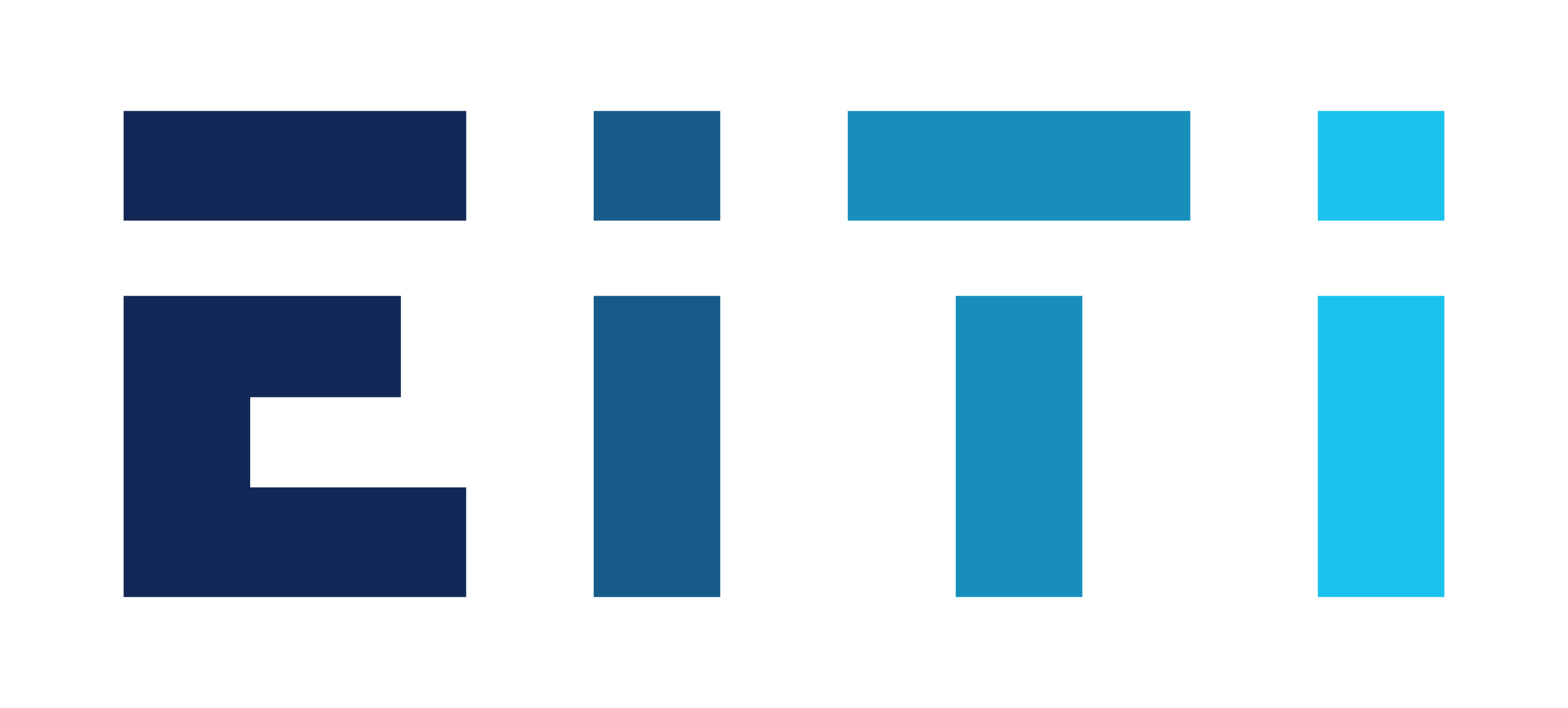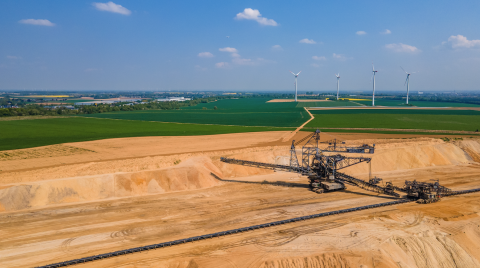
Register of licenses
EITI Requirement 2.3
This note provides guidance to multi-stakeholder groups (MSGs) on the EITI's requirement on license registers.
Summary
Most resource-rich countries have registries to help them manage their extractive industry licensing systems. License registries are databases that contain documentation related to all exploration, development and extractive rights awarded to companies. The format of such databases varies from Excel spreadsheets to sophisticated, online systems with geographical, geological and other contextual information, such as license documents.
Public disclosure of license registers enables citizens to know which companies have been awarded rights to exploit their natural resources, for what purpose, and where. This enables public oversight of extractive activities at the project level, i.e. by oil field or mine. Keeping an accurate registry system is essential to encourage investment, clarify property rights, mitigate environmental degradation, help avoid conflicts over the ownership and location of extractive sector activities, and improve oversight and accountability in the license allocation process.
Requirement 2.3 of the EITI Standard requires implementing countries to maintain up-to-date and comprehensive license registers. Registers and cadastres should document specific information for all active extractive rights, including the companies that are awarded rights and the commodities, geographical area, and time period covered by each license. Where there are legal or practical barriers to full disclosure (e.g. confidentiality clauses in legal agreements or the absence of disclosure platforms), these should be documented along with intended measures to overcome them. Where data on license registers is systematically disclosed, EITI reporting can focus on analysing and assessing the quality of disclosures.
This note provides guidance to multi-stakeholder groups (MSGs) on how to address barriers related to the disclosure of license registers and strengthen transparency surrounding extractive rights. It should be read alongside guidance on contract and license allocations (Requirement 2.2) and disclosures of beneficial ownership of license holders (Requirement 2.5).
-
Which companies hold rights to explore and exploit oil, gas and mining resources? What commodities do these companies produce, and how long are their licenses valid for?
-
How long does it typically take from when a company applies for a license and when it is granted? Are there significant discrepancies in the time of award from one license to another?
-
Where are extractive activities allowed to take place? How have public disclosures helped clarify property rights and prevent conflicts over the geographical area or legal ownership of extractive activities?
-
Are contracts and licenses granted near local communities or in areas that are vulnerable to environmental degradation?
Overview of steps
| Steps | key considerations | examples |
|---|---|---|
|
Step 1: |
|
|
|
Step 2: |
|
|
|
Step 3: |
|
|
How to implement Requirement 2.3
Step 1: Understand the license register
In accordance with Requirement 2.3.b, implementing countries are required to maintain a publicly available register or cadastre system with information about all licenses applicable to the extractive sector. In preparing for disclosures of license data, the MSG is advised to gain an understanding of the currently available information about the licensing system. This would entail reviewing the types of rights that exist, how these are recorded and who is responsible for maintaining an overview of awarded extractive rights.
The MSG may wish to consider the following questions as a basis for understanding the license system:
- What types of licenses exist?
- Which agencies have the mandate to manage the hydrocarbon and mineral licenses? Are these agencies engaged in the EITI process?
- How do these agencies maintain an overview of licenses? Are there publicly available registers/cadastre systems? Is there more than one system (e.g. systems at national, regional and local levels)? If so, are the responsibilities between the relevant agencies clearly delineated?
- What type of system currently exists for keeping a record of existing licenses (i.e. manual or computer based?)
- How often is each register updated, and who undertakes this work?
- Does the system enable monitoring of the license? If so, is it efficient in doing so?
- Are there any reforms underway on the current licensing system(s)?
In the EITI Standard, a “license” refers to any license, lease, title, permit, contract or concession which the government confers on a company(ies) or individual(s) to grant rights to explore or exploit oil, gas and/or mineral resources.
“Register” refers to the administrative system (physical or online) listing extractive licenses owned in a given sector.
A “cadastre” refers to a map that illustrates where rights are held, and contains information documented in the register such as license holders, geographical coordinates and commodities.
Dominican Republic: Cadastre at the Department of Cartography
In the Dominican Republic, the Ministry of Mines’ Department of Cartography is responsible for publishing and maintaining the cadastre of extractive licenses, which is updated twice a year. The cadastre requires some manual inputs and presents a map of existing licenses.
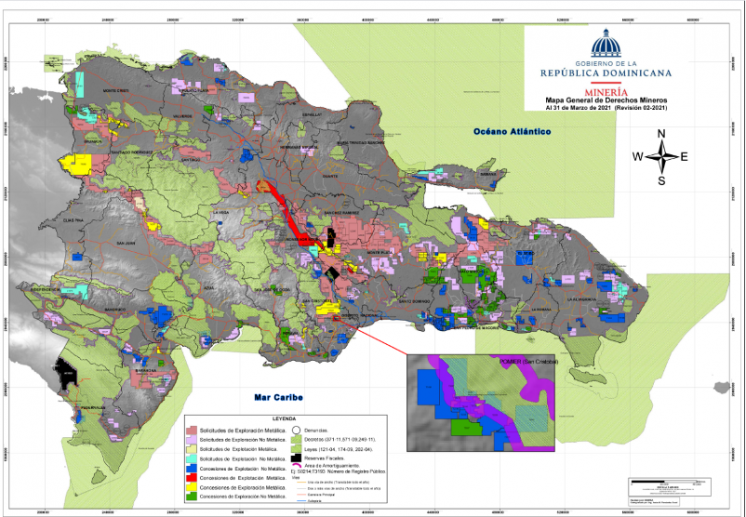
Step 2: Assess the comprehensiveness of information about licenses
MSGs are advised to review the contents of existing registries and to assess whether the information is comprehensive and reliable. The assessment should include an overview of licensing activity in the period under review.
In determining gaps in disclosure (not to be confused with identifying information contained in the systems that is not publicly accessible), the MSG is advised to consider the following questions:
- Which companies and licenses do the registries/cadastres cover? Do they include the licenses held by the companies covered in the scope of the EITI reporting cycle (as required by the EITI Standard)? If not, MSGs should present how much revenue is collected from the covered license holders as a percentage of total government extractive revenues.
- Once the scope of the registries is determined, what data is publicly available for all licenses, especially those held by companies included in EITI reporting? The following data points should be publicly accessible:
- License holder name(s). This ensures public oversight over the companies operating in a country. It is a fundamental step for ensuring a comprehensive overview of the sector and holding license holders accountable.
- Coordinates. This ensures stakeholders can assess whether companies adhere to property rights and licensing terms. However, license coordinates are not always collated in online registers or Excel tables that can easily be presented in physical EITI reports. Where coordinates are not collated, the government is still required to ensure that the area size and location of the license area are disclosed. Precise coordinates should still be accessible from the relevant government agency without unreasonable fees and restrictions. EITI reporting should include guidance on how to access the coordinates and the cost, if any, of accessing the data.
Indonesia: Monitoring geographical information
The civil society group Publish What You Pay Indonesia used coordinate data from EITI reporting to check if extractive activities were being conducted within the permitted area. The organisation equipped the indigenous community of Dayak People in West Kalimantan with drones to monitor the operations and compliance of extractive activities in their region. By assessing activities against license coordinate data, the community could ensure that companies were implementing good mining practices and complying with environmental standards.
- Date of application, date of award and duration of the license or its expiry date. In analysing the period between the application and award of a license, the MSG could consider red flags (e.g. significant delays or the period is too short to effectively assess an application). This could allow for comparisons on the duration of license allocation between different companies.
Mongolia: Analysing the duration of the licensing process
In Mongolia, stakeholders analysed the dates of license applications and awards to calculate the average duration of the awarding process and improve the license allocation procedures. Transparency International Mongolia reviewed the potential risks brought about by fragmented or incomplete license data, and how EITI and other transparency initiatives could help addressing these risks by through transparent and high-quality licensing data.
- Commodity(ies) produced or covered by the exploration license.
- How accurately do license registers reflect current license ownership (i.e. are the systems up to date)?
- How can users access changes in license ownership? Are transfers and historical information recorded in the register?
- Are there reforms underway to improve the comprehensiveness and timeliness of data disclosed in the license cadastre? If so, what are the expected timeframes for such reforms?
Togo: Exports without mineral rights and production
Togo is a big exporter of gold. According to EITI reporting, the country exports between 20 and 50 tonnes of gold each year. Yet no gold licenses are registered in Togo’s cadastre. This may indicate a gap in the government’s production reporting systems, or illegal gold transfers between Togo and neighbouring countries.
Guinea: Systematically disclosed licensing data
Guinea’s online cadastre, developed by Trimble Land Administration, covers all data requirements under Requirement 2.3.b (license holders, application/award/expiry dates, commodities and coordinates). Data is updated on an ongoing basis through a computer-based system.
However, the cadastre map only reflects the current state of ownership. It should be completed by a record of previous owners and changes of ownership in cases where licenses have been sold or transferred.
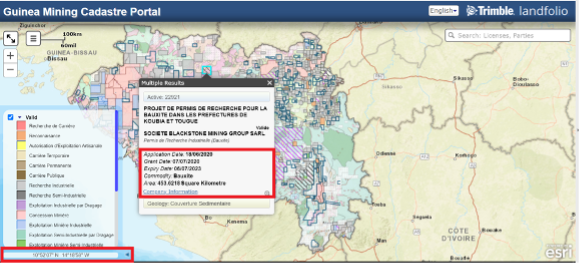
Afghanistan: Disclosing contracts and beneficial owners
In addition to providing all the required data points, the online license register of the former Ministry of Mines in Afghanistan includes links to detailed beneficial owner information on license holders. Contracts tied to individual licenses were subsequently added and can be downloaded through the portal.
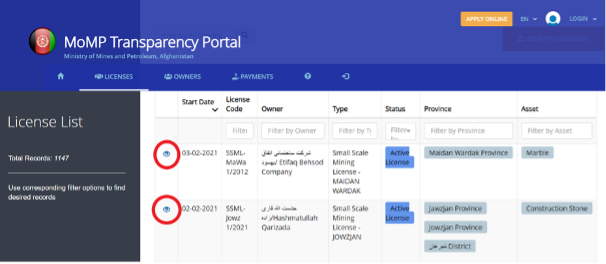
License registries must contain comprehensive license information identified above for all companies within the scope agreed by the MSG under Step 2. MSGs are also expectedThe use of the term “expected” in the EITI Standard indicates that the MSG should consider the issue and document their discussions, rationale for disclosure/non-disclosure and any barriers to disclosure. to ensure that registers will contain information about licenses held by all other entities that fall outside this scope.
For the latter aspect where there are significant legal or practical barriers preventing comprehensive disclosure of licenses and contracts, the MSG should document and explain what these barriers are. The MSG should also ensure to document government plans seeking to overcome such barriers and the anticipated timeframe for achieving them. In the absence of government-led plans, the MSG is expected to consider measures for overcoming barriers and to engage with relevant counterparts to implement them. Common obstacles may include confidentiality clauses in legal agreements, lack of disclosure platforms or monitoring systems, conflicting departmental responsibilities or low technological capacity and resources.
São Tomé and Príncipe: Practical barriers preventing disclosure of date of applications
In São Tomé and Príncipe, the archiving system of the National Agency for Petroleum (ANP) did not allow for the application dates to be recorded for oil and gas licenses granted through direct negotiations. As a result, this data was not disclosed in online registers and EITI reports. However, Validation found that the ANP planned to address this gap as part of an update to its website in 2020.
Step 3: Ensure that information is publicly available
Many countries systematically disclose some license data through online portals or online maps. Others use the EITI reporting to publish comprehensive license lists. To address information gaps in publicly accessible sources (see Step 2), the MSG should include missing information in EITI reporting. Where license disclosures are timely, comprehensive and publicly available online, the MSG can include a link to the license registry in EITI reporting or on the national EITI website.
The MSG’s assessment and recommendations to strengthen disclosures should be documented and publicly accessible, for example through an EITI Report or on the national EITI website. In its assessment, the MSG might wish to consider the following:
- Where gaps of information are identified under Step 2, how could license registries be improved to capture all the required information?
- What additional information exists within current license registries that is not publicly accessible? How could this information be made publicly available?
- How is the data presented (i.e. can data be downloaded or view in open formats) and accessed (i.e. is it free to access and/or is registration required)?
- How can the record-keeping and management of license registries be improved, for current or historical data?
The MSG might also wish to consider how license data can be linked to other types of disclosures, such as the process for awarding licenses, the corresponding contracts and how the relevant government agencies can monitor the implementation of license holders’ contractual obligations.
Sierra Leone: License register in open format
Sierra Leone’s online license register, developed by the Revenue Development Foundation, is hosted by the National Minerals Agency. License data can be downloaded. However, some data points, such as the coordinates, might not be available. Access does require registration of basic information in order to use these features.
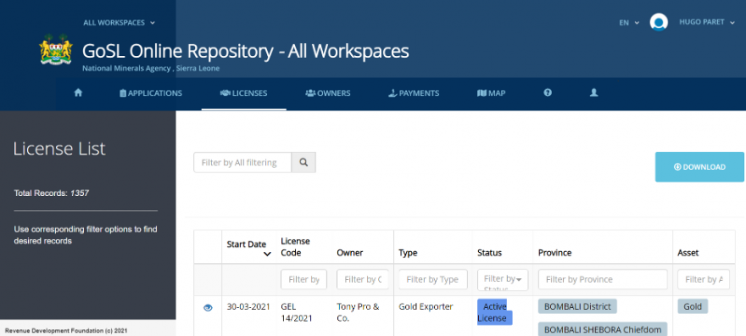
Côte d’Ivoire: Geographical presentation of coordinates
Côte d’Ivoire’s license register, developed by Trimble Landfolio (previously Flexicadastre), allows easy access to all license data, including coordinates. The cadastre allows for other types of layers to be included, such as artisanal mining zones, protected forests and national parks. The platform could be further improved by presenting data in table format or by adding a download function for further analysis.
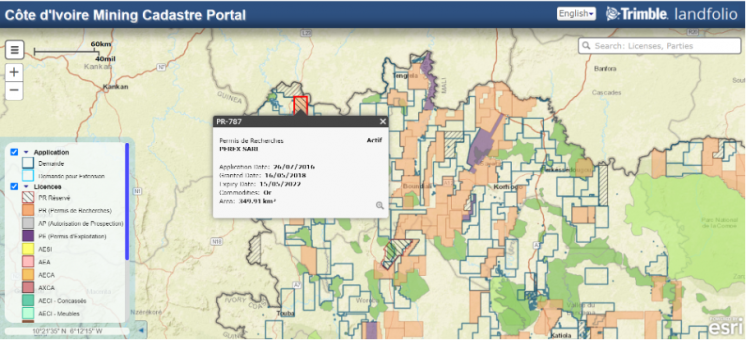
Albania: EITI reporting addressing data gaps
Albania has several online license registers maintained by different administrations, including the Ministry of Energy (MIE), the National Agency of Natural Resources (AKBN), and the Albanian Geological Survey (SHGJSH). However, these registers are not comprehensive and do not provide license coordinates.
ALBEITI therefore maintains its own register of active licenses on its own website, updated manually twice a year, which includes coordinate information. ALBEITI verifies the information from source registers hosted by MIE, AKBN and SHGJSH and the National Business Centre. Prior to publication, ALBEITI also cross-checks lists disclosed by the Ministry of Energy and the regulator (MIE and AKBN) on their respective websites. Any discrepancy or inconsistency noted is resolved with the MIE and AKBN before any registers are updated in ALBETI’s website. Coordinates missing from the three source registers are then added to the EITI repository.
This example demonstrates how the EITI process can address gaps in government and company disclosure systems in the short term. The longer-term aim should be to strengthen disclosures of existing license registries at the source.
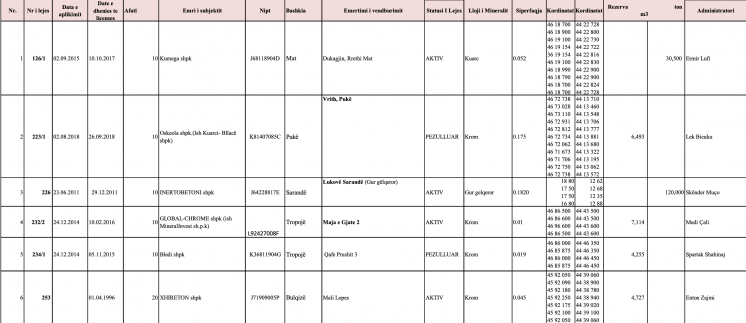
Further resources
- EITI (2021), Guidance Note: EITI Requirement 2.2.
- Natural Resource Governance Institute and Open Contracting Partnership (2018), Open Contracting for Oil, Gas and Mineral Rights: Shining a Light on Good Practice, pp. 49-50.
